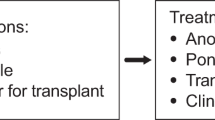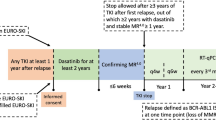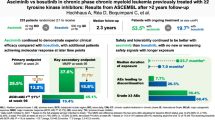Abstract
Impressive response rates and good tolerability have led imatinib 400 mg once a day to become the standard frontline therapy for chronic myeloid leukemia (CML) patients. However, approximately one-third of the treated patients do not respond in an optimal manner to this drug, and the appropriate type and rhythm of CML monitoring, as well as the correct action to be undertaken in case of failure or suboptimal responses to imatinib therapy have been published in specific recommendations by European Leukemia Net and National Comprehensive Cancer Network. Failure and also cytogenetic suboptimal responses strongly demand for a change in treatment and for a switch from imatinib to one of the two second-generation tyrosine kinase inhibitors (TKIs) so far registered, dasatinib and nilotinib, for which efficacy as second-line therapy in imatinib-resistant or intolerant cases has been clearly demonstrated in phase II studies, and for which 4-year updates are now available. Other TKIs, at the moment, still under clinical investigation for imatinib-resistant patients include bosutinib and the next-generation TKI ponatinib. Different efficacy and safety criteria characterize each of the mentioned compounds and may help to decide on the one to be preferably used in individual patients.
This is a preview of subscription content, access via your institution
Access options
Subscribe to this journal
We are sorry, but there is no personal subscription option available for your country.
Buy this article
- Purchase on Springer Link
- Instant access to full article PDF
Prices may be subject to local taxes which are calculated during checkout
Similar content being viewed by others
References
O’Brien SG, Guilhot F, Larson RA, Gathmann I, Baccarani M, Cervantes F et al. Imatinib compared with interferon and low-dose cytarabine for newly diagnosed chronic-phase chronic myeloid leukemia. N Engl J Med 2003; 348: 994–1004.
Druker BJ, Guilhot F, O’Brien SG, Gathmann I, Kantarjian H, Gattermann N et al. Five-year follow-up of patients receiving imatinib for chronic myeloid leukemia. N Engl J Med 2006; 355: 2408–2417.
Deininger M, O’Brien SG, Guilhot F, Goldman JM, Hochhaus A, Hughes TP et al. International Randomized Study of Interferon vs STI571 (IRIS) 8-year follow up: sustained survival and low risk for progression or events in patients with newly diagnosed chronic myeloid leukemia in chronic phase (CML-CP) treated with imatinib. Blood 2009; 114: 462.
Baccarani M, Cortes J, Pane F, Niederwieser D, Saglio G, Apperley J et al. Chronic myeloid leukemia: an update of concepts and management recommendations of European LeukemiaNet. J Clin Oncol 2009; 27: 6041–6051.
Hehlmann R, Lauseker M, Jung-Munkwitz S, Leitner A, Müller MC, Pletsch N et al. Tolerability-adapted imatinib 800 mg/d versus 400 mg/d versus 400 mg/d plus interferon-alpha in newly diagnosed chronic myeloid leukemia. J Clin Oncol 2011; 29: 1634–1642.
de Lavallade H, Apperley JF, Khorashad JS, Milojkovic D, Reid AG, Bua M et al. Imatinib for newly diagnosed patients with chronic myeloid leukemia: incidence of sustained responses in an intention-to-treat analysis. J Clin Oncol 2008; 26: 3358–3363.
Doggrell SA . BMS-354825: a novel drug with potential for the treatment of imatinib-resistant chronic myeloid leukaemia. Expert Opin Investig Drugs 2005; 14: 89–91.
Weisberg E, Manley P, Mestan J, Cowan-Jacob S, Ray A, Griffin JD . AMN107 (nilotinib): a novel and selective inhibitor of BCR-ABL. Br J Cancer 2006; 94: 1765–1769.
Talpaz M, Shah NP, Kantarjian H, Donato N, Nicoll J, Paquette R et al. Dasatinib in imatinib-resistant Philadelphia chromosome-positive leukemias. N Engl J Med 2006; 354: 2531–2541.
Shah NP, Kantarjian HM, Kim DW, Réa D, Dorlhiac-Llacer PE, Milone JH et al. Intermittent target inhibition with dasatinib 100 mg once daily preserves efficacy and improves tolerability in imatinib-resistant and -intolerant chronic-phase chronic myeloid leukemia. J Clin Oncol 2008; 26: 3204–3212.
Kantarjian HM, Giles FJ, Bhalla KN, Pinilla-Ibarz J, Larson RA, Gattermann N et al. Nilotinib is effective in patients with chronic myeloid leukemia in chronic phase after imatinib resistance or intolerance: 24-month follow-up results. Blood 2011; 117: 1141–1145.
Baccarani M, Saglio G, Goldman J, Hochhaus A, Simonsson B, Appelbaum F et al. Evolving concepts in the management of chronic myeloid leukemia: recommendations from an expert panel on behalf of the European LeukemiaNet. Blood 2006; 108: 1809–1820.
Jabbour E, Saglio G, Hughes TP, Kantarjian H . Suboptimal responses in chronic myeloid leukemia: Implications and management strategies. Cancer 2011; 118: 1181–1191.
Marin D, Milojkovic D, Olavarria E, Khorashad JS, de Lavallade H, Reid AG et al. European LeukemiaNet criteria for failure or suboptimal response reliably identify patients with CML in early chronic phase treated with imatinib whose eventual outcome is poor. Blood 2008; 112: 4437–4444.
Iacobucci I, Saglio G, Rosti G, Testoni N, Pane F, Amabile M et al. Achieving a major molecular response at the time of a complete cytogenetic response (CCgR) predicts a better duration of CCgR in imatinib-treated chronic myeloid leukemia patients. Clin Cancer Res 2006; 12: 3037–3042.
Baccarani M, Dreyling M, Grp EGW . Chronic myeloid leukaemia: ESMO Clinical Practice Guidelines for diagnosis, treatment and follow-up. Ann Oncol 2010; 21: v165–v167.
Jabbour E, Branford S, Saglio G, Jones D, Cortes JE, Kantarjian HM . Practical advice for determining the role of BCR-ABL mutations in guiding tyrosine kinase inhibitor therapy in patients with chronic myeloid leukemia. Cancer 2011; 117: 1800–1811.
Soverini S, Hochhaus A, Nicolini FE, Gruber F, Lange T, Saglio G et al. BCR-ABL kinase domain mutation analysis in chronic myeloid leukemia patients treated with tyrosine kinase inhibitors: recommendations from an expert panel on behalf of European LeukemiaNet. Blood 2011; 118: 1208–1215.
Branford S, Hughes TP . Mutational analysis in chronic myeloid leukemia: when and what to do? Curr Opin Hematol 2011; 18: 111–116.
Shah NP, Kim DW, Kantarjian H, Rousselot P, Llacer PE, Enrico A et al. Potent, transient inhibition of BCR-ABL with dasatinib 100 mg daily achieves rapid and durable cytogenetic responses and high transformation-free survival rates in chronic phase chronic myeloid leukemia patients with resistance, suboptimal response or intolerance to imatinib. Haematologica 2010; 95: 232–240.
O’Hare T EC, Deininger MW . Bcr-Abl kinase domain mutations, drug resistance, and the road to a cure for chronic myeloid leukemia. Blood 2007; 110: 2242–2249.
Hughes T, Saglio G, Branford S, Soverini S, Kim DW, Müller MC et al. Impact of baseline BCR-ABL mutations on response to nilotinib in patients with chronic myeloid leukemia in chronic phase. J Clin Oncol 2009; 27: 4204–4210.
Muller MC, Cortes JE, Kim DW, Druker BJ, Erben P, Pasquini R et al. Dasatinib treatment of chronic-phase chronic myeloid leukemia: analysis of responses according to preexisting BCR-ABL mutations. Blood 2009; 114: 4944–4953.
Jabbour E, Branford S, Saglio G, Jones D, Cortes JE, Kantarjian HM . Practical advice for determining the role of BCR-ABL mutations in guiding tyrosine kinase inhibitor therapy in patients with chronic myeloid leukemia. Cancer 2010; 117: 1800–1811.
Saglio G, Kim DW, Issaragrisil S, le Coutre P, Etienne G, Lobo C et al. Nilotinib versus imatinib for newly diagnosed chronic myeloid leukemia. N Engl J Med 2010; 362: 2251–2259.
Kantarjian H, Shah NP, Hochhaus A, Cortes J, Shah S, Ayala M et al. Dasatinib versus imatinib in newly diagnosed chronic-phase chronic myeloid leukemia. N Engl J Med 2010; 362: 2260–2270.
Kim DW, Goh YT, Hsiao HH, Caguioa PB, Kim D, Kim WS et al. Clinical profile of dasatinib in Asian and non-Asian patients with chronic myeloid leukemia. Int J Hematol 2009; 89: 664–672.
Kantarjian HM, Hochhaus A, Saglio G, De Souza C, Flinn IW, Stenke L et al. Nilotinib versus imatinib for the treatment of patients with newly diagnosed chronic phase, Philadelphia chromosome-positive, chronic myeloid leukaemia: 24-month minimum follow-up of the phase 3 randomised ENESTnd trial. Lancet Oncol 2011; 12: 841–851.
Breccia M, Loglisci G, Salaroli A, Serrao A, Alimena G . Nilotinib-mediated increase in fasting glucose level is reversible, does not convert to type 2 diabetes and is likely correlated with increased body mass index. Leuk Res 2012; 36: e66–e67.
Saglio G, Larson RA, Hughes TP, Issaragrisi S, Turkina AG, Marin D et al. Efficacy and safety of nilotinib in chronic phase (CP) chrome myeloid leukemia (CML) patients (Pts) with type 2 diabetes in the ENESTnd Trial. Blood 2010; 116: 1405–1406.
Le Coutre P, Rea D, Abruzzese E, Dombret H, Trawinska MM, Herndlhofer S et al. Severe peripheral arterial disease during nilotinib therapy. J Natl Cancer Inst 2011; 103: 1347–1348.
Montani D, Bergot E, Günther S, Savale L, Bergeron A, Bourdin A et al. Pulmonary arterial hypertension in patients treated by dasatinib. Circulation 2012; 125: 2128–2137.
Acknowledgements
This work has been supported by grants from AIL (Associazione Italiana contro le Leucemie) and AIRC (Associazione Italiana per la Ricerca sul Cancro).
Author information
Authors and Affiliations
Corresponding author
Ethics declarations
Competing interests
GS has received consulting and lecture fees from Novartis AG and Bristol-Myers Squibb.
Additional information
This article was published as part of a supplement that was supported by Novartis, MSD Italia, Roche, Celgene, GlaxoSmithKline, Sanofi, Gilead, Adienne, Italfarmaco, Pierre Fabre Pharmaceuticals with an unrestricted educational contribution to AREO—Associazione Ricerche Emato-Oncologiche (Genoa) and AMS—Associazione Malattie del Sangue (Milan) for the purpose of advancing research in acute and chronic leukemia.
Rights and permissions
About this article
Cite this article
Saglio, G. Second-generation TKIs: which and when?. Leukemia Suppl 1 (Suppl 2), S40–S42 (2012). https://doi.org/10.1038/leusup.2012.22
Published:
Issue Date:
DOI: https://doi.org/10.1038/leusup.2012.22



